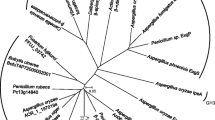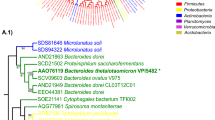Abstract
Diglycosidases hydrolyze the heterosidic linkage of diglycoconjugates, releasing the disaccharide and the aglycone. Usually, these enzymes do not hydrolyze or present only low activities towards monoglycosylated compounds. The flavonoid degrading fungus Acremonium sp. DSM 24697 produced two diglycosidases, which were termed 6-O-α-rhamnosyl-β-glucosidase I and II (αRβG I and II) because of their function of releasing the disaccharide rutinose (6-O-α-L-rhamnosyl-β-D-glucose) from the diglycoconjugates hesperidin or rutin. In this work, the genome of Acremonium sp. DSM 24697 was sequenced and assembled with a size of ~ 27 Mb. The genes encoding αRβG I and II were expressed in Pichia pastoris KM71 and the protein products were purified with apparent molecular masses of 42 and 82 kDa, respectively. A phylogenetic analysis showed that αRβG I grouped in glycoside hydrolase family 5, subfamily 23 (GH5), together with other fungal diglycosidases whose substrate specificities had been reported to be different from αRβG I. On the other hand, αRβG II grouped in glycoside hydrolase family 3 (GH3) and thus is the first GH3 member that hydrolyzes the heterosidic linkage of rutinosylated compounds. The substrate scopes of the enzymes were different: αRβG I showed exclusive specificity toward 7-O-β-rutinosyl flavonoids, whereas αRβG II hydrolyzed both 7-O-β-rutinosyl- and 3-O-β-rutinosyl- flavonoids. None of the enzymes displayed activity toward 7-O-β-neohesperidosyl- flavonoids. The recombinant enzymes also exhibited transglycosylation activities, transferring rutinose from hesperidin or rutin onto various alcoholic acceptors. The different substrate scopes of αRβG I and II may be part of an optimized strategy of the original microorganism to utilize different carbon sources.





Similar content being viewed by others
References
Altschul SF, Gish W, Miller W, Myers EW, Lipman DJ (1990) Basic local alignment search tool. J Mol Biol 215:403–410
Aspeborg H, Coutinho PM, Wang Y, Brumer H, Henrissat B (2012) Evolution, substrate specificity and subfamily classification of glycoside hydrolase family 5 (GH5). BMC Evol Biol 12:186
Bassanini I, Krejzová J, Panzeri W, Křen V, Monti D, Riva S (2017) A sustainable one-pot two-enzymes synthesis of naturally occurring arylalkyl glucosides. ChemSusChem 10:2040–2045
Bojarová P, Křen V (2009) Glycosidases: a key to tailored carbohydrates. Trends Biotechnol 27:199–209
Cutfield SM, Davies GJ, Murshudov G, Anderson BF, Moody PCE, Sullivan PA, Cutfield JF (1999) The structure of the exo-β-(1,3)-glucanase from Candida albicans in native and bound forms: relationship between a pocket and groove in family 5 glycosyl hydrolases. J Mol Biol 294:771–783
Fries A, Mazzaferro LS, Grüning B, Bisel P, Stibal K, Buchholz PCF, Pleiss J, Sprenger GA, Müller M (2019) Alteration of the route to menaquinone towards isochorismate-derived metabolites. ChemBioChem. https://doi.org/10.1002/cbic.201900050
Gerlt JA (2017) Genomic enzymology: web tools for leveraging protein family sequence-function space and genome context to discover novel functions. Biochem 56:4293–4308
Goudot A, Pourceau G, Meyer A, Gehin T, Vidal S, Vasseur JJ, Morvan F, Souteyrand E, Chevolot Y (2013) Quantitative analysis (Kd and IC50) of glycoconjugates interactions with a bacterial lectin on a carbohydrate microarray with DNA Direct Immobilization (DDI). Biosens Bioelectron 40:153–160
Gudmundsson M, Hansson H, Karkehabadi S, Larsson A, Stals I, Kim S, Sunux S, Fujdala M, Larenas E, Kaper T, Sandgren M (2016) Structural and functional studies of the glycoside hydrolase family 3 β-glucosidase Cel3A from the moderately thermophilic fungus Rasamsonia emersonii. Acta Cryst 72:860–870
Ishikawa M, Kawasaki M, Shiono Y, Koseki T (2018) A novel Aspergillus oryzae diglycosidase that hydrolyzes 6-O-α-L-rhamnosyl-β-D-glucoside from flavonoids. Appl Microbiol Biotechnol 102:3193–3201
Katayama S, Ohno F, Yamauchi Y, Kato M, Makabe H, Nakamura S (2013) Enzymatic synthesis of novel phenol acid rutinosides using rutinase and their antiviral activity in vitro. J Agric Food Chem 61:6917–6962
Karkehabadi S, Helmich KE, Kaper T, Hansson H, Mikkelsen N, Gudmundsson M, Piens G, Fujdala M, Banerjee G, Scott-Craig J, Walton JD, Phillips GN, Sandgren M (2014) Biochemical characterization and crystal structures of a fungal family 3 glucosidase, Cel3A from Hypocrea jecorina. J Biol Chem 289:31624–31637
Kato Y, Matsushita J, Kubodera T, Matsuda K (1985) A novel enzyme producing isoprimeverose from oligoxyloglucans of Aspergillus oryzae. J Biochem 97:801–810
Křen V, Martínková L (2001) Glycosides in medicine: “The role of glycosidic residue in biological activity”. Curr Med Chem 8:1303–1328
Křen V, Řezanka T (2008) Sweet antibiotics – the role of glycosidic residues in antibiotic and antitumor activity and their randomization. FEMS Microbiol Rev 32:858–889
Ma SJ, Mizutani M, Hiratake J, Hayashi K, Yagi K, Watanabe N, Sakata K (2001) Substrate specificity of β-primeverosidase, a key enzyme in aroma formation during oolong tea and black tea manufacturing. Biosci Biotechnol Biochem 65:2719–2729
Matsuzawa T, Mitsuishi Y, Kameyama A, Yaoi K (2016) Identification of the gene encoding isoprimeverose-producing oligoxyloglucan hy- drolase in Aspergillus oryzae. J Biol Chem 291:5080–5087
Mazzaferro L, Breccia JD (2011) Functional and biotechnological insights into diglycosidases. Biocat Biotransf 29:103–112
Mazzaferro LS, Weiz G, Braun L, Kotik M, Pelantová H, Křen V, Breccia JD (2019) Enzyme-mediated transglycosylation of rutinose (6- -α- -rhamnosyl- -glucose) to phenolic compounds by a diglycosidase from sp. DSM 24697 . Biotech Appl Biochem 66 :53–59
Mazzaferro L, Piñuel L, Minig M, Breccia JD (2010) Extracellular monoenzyme deglycosylation system of 7-O-linked flavonoid β-rutinosides and its disaccharide transglycosylation activity from Stilbella fimetaria. Arch Microbiol 192:383–393 Erratum in: Arch Microbiol 2011 193:461
Mazzaferro LS, Piñuel L, Erra-Balsells R, Giudicessi SL, Breccia JD (2012) Transglycosylation specificity of Acremonium sp. α-rhamnosyl-β-glucosidase and its application to the synthesis of the new fluorogenic substrate 4-methylumbelliferyl-rutinoside. Carbohydr Res 347:69–75
Miller GL (1959) Use of Dinitrosalicylic Acid Reagent for Determination of Reducing Sugar. Anal Chem 31:426–428
Minig M, Mazzaferro LS, Erra-Balsells R, Petroselli G, Breccia JD (2011) α-Rhamnosyl-β-glucosidase-Catalyzed Reactions for Analysis and Biotransformations of Plant-Based Foods. J Agric Food Chem 59 :11238–11243
Mizutani M, Nakanishi H, Ema J, Ma SJ, Noguchi E, Inohara-Ochiai M, Fukuchi-Mizutani M, Nakao M, Sakata K (2002) Cloning of β-primeverosidase from tea leaves, a key enzyme in tea aroma formation. Plant Physiol 130:2164–2176
Neher BD, Mazzaferro LS, Kotik M, Oyhenart J, Halada P, Křen V, Breccia JD (2016) Bacteria as source of diglycosidase activity: Actinoplanes missouriensis produces 6-O-α-L-rhamnosyl-β-D-glucosidase active on flavonoids. Appl Microbiol Biotechnol 100:3061–3070
Patrick WM, Nakatani Y, Cutfield SM, Sharpe ML, Ramsay RJ, Cutfield JF (2010) Carbohydrate binding sites in Candida albicans exo-β-1,3-glucanase and the role of the Phe-Phe ‘clamp’ at the active site entrance. FEBS J 277:4549–4561
Petersen TN, Brunak S, von Heijne G, Nielsen H (2011) SignalP 4.0: discriminating signal peptides from transmembrane regions. Nat Methods 8:785–786
Peterson JJ, Beecher GR, Bhagwat SA, Dwyer JT, Gebhardt SE, Haytowitz DB, Holden JM (2006) Flavanones in grapefruit, lemons, and limes: a compilation and review of the data from the analytical literature. J Food Compos Anal 19:S74–S80
Pozzo T, Pasten JL, Karlsson EN, Logan DT (2010) Structural and functional analyses of glucosidase 3B from Thermotoga neapolitana: A thermostable three-domain representative of glycoside hydrolase 3. J Mol Biol 397:724–739
Robinson MA, Charlton ST, Garnier P, Wang X, Davis SS, Perkins AC, Frier M, Duncan R, Savage TJ, Wyatt DA, Watson SA, Davis BG (2004) LEAPT: lectin-directed enzyme-activated prodrug therapy. Proc Natl Acad Sci U S A 101:14527–14532
Šimčíková D, Kotik M, Weignerová L, Halada P, Pelantová H, Adamcová K, Křen V (2015) α-L-Rhamnosyl-β-D-glucosidase (rutinosidase) from Aspergillus niger: characterization and synthetic potential of a novel diglycosidase. Adv Synth Catal 356:1–12
Stanke M, Morgenstern B (2005) AUGUSTUS: a web server for gene prediction in eukaryotes that allows user-defined constraints. Nucleic Acids Res 33(suppl 2):W465–W467
Suzuki K, Sumitani JI, Nam YW, Nishimaki T, Tani S, Wakagi T, Kawaguchi T, Fushinobu S (2013) Crystal structures of glycoside hydrolase family 3 glucosidase 1 from Aspergillus aculeatus. Biochem J 452:211–221
Takahashi M, Konishi T, Takeda T (2011) Biochemical characterization of Magnaporthe oryzae β-glucosidases for efficient β-glucan hydrolysis. Appl Microbiol Biotechnol 91:1073–1082
Thompson JD, Higgins DG, Gibson TJ (1994) CLUSTAL W: improving the sensitivity of progressive multiple sequence alignment through sequence weighting, position-specific gap penalties and weight matrix choice. Nucleic Acids Res 22:4673–4680
Tsuruhami K, Mori S, Amarume S, Saruwatari S, Murata T, Hirakake J, Sakata K, Usui T (2006) Isolation and characterization of a β-primeverosidase-like enzyme from Penicillium multicolor. Biosci Biotechnol Biochem 70:691–698
Tsuruhami K, Mori S, Koide Y (2011) Diglycosidase and gene encoding the same. Patent US 7998721 B2
Weiz G, Breccia JD, Mazzaferro LS (2017) Screening and quantification of the enzymatic deglycosylation of the plant flavonoid rutin by UV–visible spectrometry. Food Chem 229:44–49
Yamamoto S, Okada M, Usui T, Sakata K (2002) Isolation and characterization of a β-primeverosidase-like endo-manner β-glycosidase from Aspergillus fumigatus AP-20. Biosci Biotechnol Biochem 66:801–807
Yoshida E, Hidaka M, Fushinobu S, Koyanagi T, Minami H, Tamaki H, Kitaoka M, Katayama T, Kumagai H (2010) Role of a PA14 domain in determining substrate specificity of a glycoside hydrolase family 3 glucosidase from Kluyveromyces marxianus. Biochem J 431:39–49
Funding
This work was supported by the National University of La Pampa (UNLPam), the National Council of Scientific and Technical Research (CONICET), and The National Agency for Science and Technology Promotion (ANPCyT) of Argentina. The return fellowship to L.S.M. (grant number 1147746) from the Alexander von Humboldt Foundation is sincerely acknowledged. We acknowledge support from the Czech Science Foundation (grant no. 19-00091S). Funding of the bilateral cooperation project 7AMB13AR005 by the Ministry of Education, Youth and Sports (MEYS) of the Czech Republic and the Ministry of Science, Technology and Innovation (MINCYT) of Argentina is acknowledged.
Author information
Authors and Affiliations
Corresponding author
Ethics declarations
Conflict of interest
The authors declare that they have no competing interests.
Ethical approval
This article does not contain any studies with human participants or animals performed by any of the authors.
Additional information
Publisher’s note
Springer Nature remains neutral with regard to jurisdictional claims in published maps and institutional affiliations.
Electronic supplementary material
ESM 1
(PDF 941 kb)
Rights and permissions
About this article
Cite this article
Weiz, G., Mazzaferro, L.S., Kotik, M. et al. The flavonoid degrading fungus Acremonium sp. DSM 24697 produces two diglycosidases with different specificities. Appl Microbiol Biotechnol 103, 9493–9504 (2019). https://doi.org/10.1007/s00253-019-10180-y
Received:
Revised:
Accepted:
Published:
Issue Date:
DOI: https://doi.org/10.1007/s00253-019-10180-y




